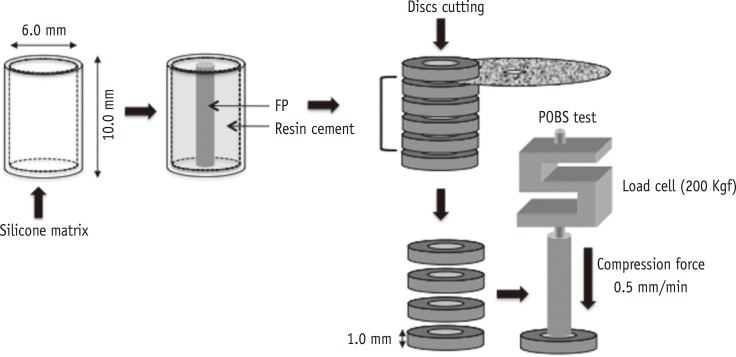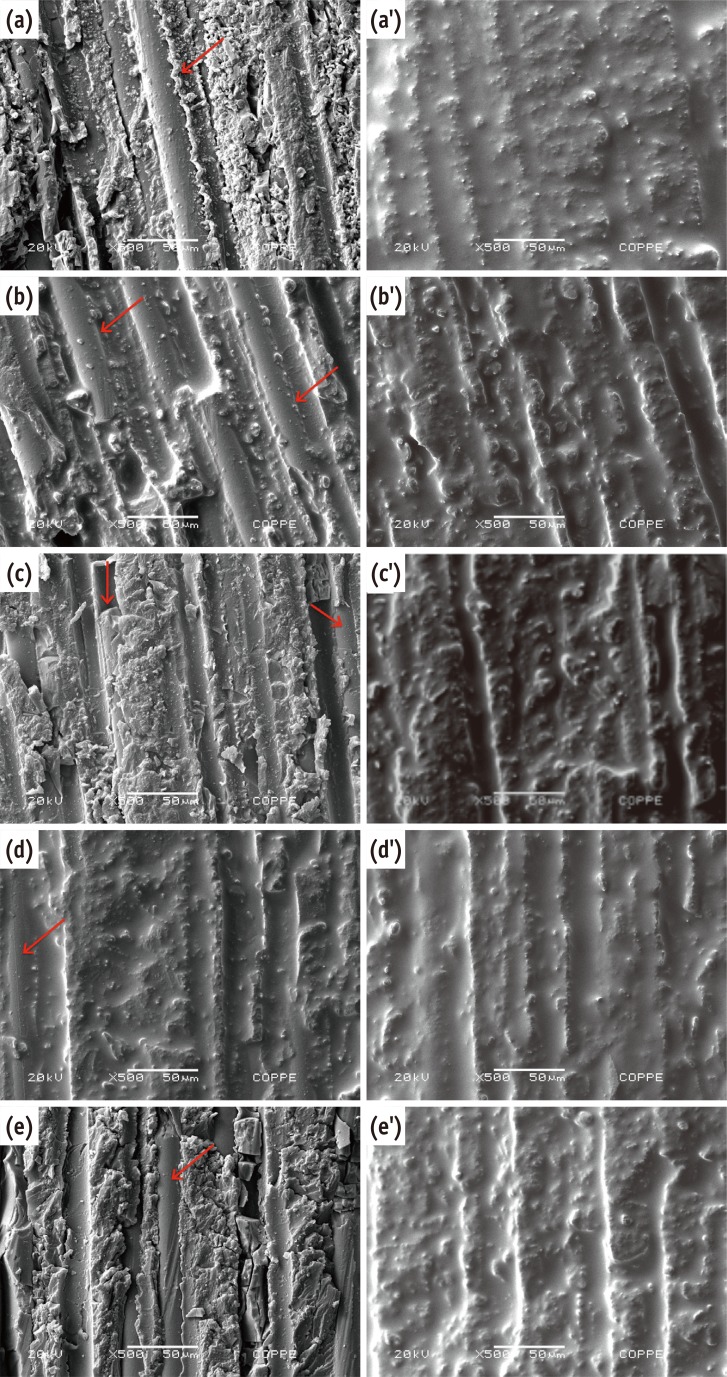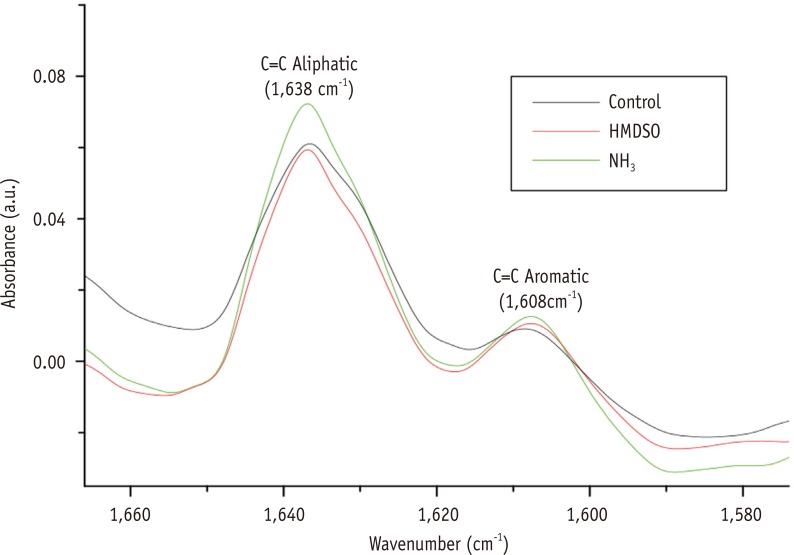Restor Dent Endod.
2017 May;42(2):125-133. 10.5395/rde.2017.42.2.125.
The effects of non-thermal plasma and conventional treatments on the bond strength of fiber posts to resin cement
- Affiliations
-
- 1Metallurgical and Materials Engineering, Federal University of Rio de Janeiro, Rio de Janeiro, Brazil. maira@metalmat.ufrj.br
- 2Analytical Laboratory of Restorative Biomaterials - LABiom-R, School of Dentistry, Federal Fluminense University, Niterói, Brazil.
- 3Department of Dental Clinics, Federal University of Rio de Janeiro, Rio de Janeiro, Brazil.
- KMID: 2379462
- DOI: http://doi.org/10.5395/rde.2017.42.2.125
Abstract
OBJECTIVES
This study compared the effect of hexamethyldisiloxane (HMDSO) and ammonia (NH₃) plasmas on the bond strength of resin cement to fiber posts with conventional treatments.
MATERIALS AND METHODS
Sixty-five fiber posts were divided into 5 groups: Control (no surface treatment); H₂O₂ (24% hydrogen peroxide for 1 min); Blasting (blasting with aluminum oxide for 30 sec); NH₃ (NH₃ plasma treatment for 3 min); HMDSO (HMDSO plasma treatment for 15 min). After the treatments, the Ambar adhesive (FGM Dental Products) was applied to the post surface (n = 10). The fiber post was inserted into a silicon matrix that was filled with the conventional resin cement Allcem Core (FGM). Afterwards, the post/cement specimens were cut into discs and subjected to a push-out bond strength (POBS) test. Additionally, 3 posts in each group were evaluated using scanning electron microscopy. The POBS data were analyzed by one-way analysis of variance and the Tukey's honest significant difference post hoc test (α = 0.05).
RESULTS
The Blasting and NH₃ groups showed the highest POBS values. The HMDSO group showed intermediate POBS values, whereas the Control and H₂O₂ groups showed the lowest POBS values.
CONCLUSION
Blasting and NH₃ plasma treatments were associated with stronger bonding of the conventional resin cement Allcem to fiber posts, in a procedure in which the Ambar adhesive was used.
Keyword
MeSH Terms
Figure
Reference
-
1. Reeh ES, Messer HH, Douglas WH. Reduction in tooth stiffness as a result of endodontic and restorative procedure. J Endod. 1989; 15:512–516. PMID: 2639947.2. Garoushi S, Vallittu PK, Lassila LV. Direct restoration of severely damaged incisors using short fiber-reinforced composite resin. J Dent. 2007; 35:731–736. PMID: 17614187.
Article3. Vârlan C, Dimitriu B, Vârlan V, Bodnar D, Suciu I. Current opinions concerning the restoration of endodontically treated teeth: basic principles. J Med Life. 2009; 2:165–172. PMID: 20108535.4. Yavirach P, Chaijareenont P, Boonyawan D, Pattamapun K, Tunma S, Takahashi H, Arksornnukit M. Effects of plasma treatment on the shear bond strength between fiber-reinforced composite posts and resin composite for core build-up. Dent Mater J. 2009; 28:686–692. PMID: 20019419.
Article5. Asmussen E, Peutzfeldt A, Heitmann T. Stiffness, elastic limit, and strength of newer types of endodontic posts. J Dent. 1999; 27:275–278. PMID: 10193104.
Article6. Vichi A, Grandini S, Davidson CL, Ferrari M. An SEM evaluation of several adhesive systems used for bonding fiber posts under clinical conditions. Dent Mater. 2002; 18:495–502. PMID: 12191661.
Article7. Monticelli F, Toledano M, Tay FR, Sadek FT, Goracci C, Ferrari M. A simple etching technique for improving the retention of fiber posts to resin composites. J Endod. 2006; 32:44–47. PMID: 16410067.
Article8. Monticelli F, Osorio R, Sadek FT, Radovic I, Toledano M, Ferrari M. Surface treatments for improving bond strength to prefabricated fiber posts: a literature review. Oper Dent. 2008; 33:346–355. PMID: 18505227.
Article9. de Sousa Menezes M, Queiroz EC, Soares PV, Faria-e-Silva AL, Soares CJ, Martins LR. Fiber post etching with hydrogen peroxide: effect of concentration and application time. J Endod. 2011; 37:398–402. PMID: 21329829.
Article10. Naves LZ, Santana FR, Castro CG, Valdivia AD, Da Mota AS, Estrela C, Correr-Sobrinho L, Soares CJ. Surface treatment of glass fiber and carbon fiber posts: SEM characterization. Microsc Res Tech. 2011; 74:1088–1092. PMID: 21538694.
Article11. Elsaka SE. Influence of chemical surface treatments on adhesion of fiber posts to composite resin core materials. Dent Mater. 2013; 29:550–558. PMID: 23518246.
Article12. Liu C, Liu H, Qian YT, Zhu S, Zhao SQ. The influence of four dual-cure resin cements and surface treatment selection to bond strength of fiber post. Int J Oral Sci. 2014; 6:56–60. PMID: 24177170.
Article13. Costa Dantas MC, do Prado M, Costa VS, Gaiotte MG, Simão RA, Bastian FL. Comparison between the effect of plasma and chemical treatments on fiber post surface. J Endod. 2012; 38:215–218. PMID: 22244639.
Article14. Spyrides SM, Prado Md, Simão RA, Bastian FL. Effect of plasma and fiber position on flexural properties of a polyethylene fiber-reinforced composite. Braz Dent J. 2015; 26:490–496. PMID: 26647934.
Article15. Prado Md, Roizenblit RN, Pacheco LV, Barbosa CA, Lima CO, Simão RA. Effect of argon plasma on root dentin after use of 6% NaOCl. Braz Dent J. 2016; 27:41–45. PMID: 27007344.
Article16. Garcia-Perez T, Rodriguez E, Bittencourt E, Jova Z. Activation of HMDSO thin film with low pressure argon plasma and vaccum ultraviolet radiation. Lat Am Appl Res. 2012; 42:19–25.17. Spyrides SM, Prado Md, Araujo JR, Simão RA, Bastian FL. Effects of plasma on polyethylene fiber surface for prosthodontic application. J Appl Oral Sci. 2015; 23:614–622. PMID: 26814463.18. Hayakawa T, Yoshinari M, Nemoto K. Characterization and protein-adsorption behavior of deposited organic thin film onto titanium by plasma polymerization with hexamethyldisiloxane. Biomaterials. 2004; 25:119–127. PMID: 14580915.
Article19. Vautrin-UI C, Boisse-Laporteb C, Benissadb N, Chaussea A, Leprinceb P, Messinaa R. Plasma-polymerized coatings using HMDSO precursor for iron protection. Prog Org Coat. 2000; 38:9–15.20. Fernandes JCS, Ferreria MGS, Haddaw DB, Goruppa A, Short R, Dixon DG. Plasma-polymerized coatings used as pre-treatment for aluminum alloys. Surf Coat Technol. 2002; 154:8–13.21. Gengenbach TR, Xie X, Chatelier RC, Griesser HJ. Evolution of the surface composition and topography of perfluorinated polymers following ammonia-plasma treatment. J Adhes Sci Technol. 1994; 8:305–328.
Article22. Wu DY, Gutowski WS, Li S, Griesser HJ. Ammonia plasma treatment of polyolefins for adhesive bonding with a cyanoacrylate adhesive. J Adhes Sci Technol. 1995; 9:501–525.23. Yang J, Bei J, Wang S. Improving cell affinity of poly(D,L-lactide) film modified by anhydrous ammonia plasma treatment. Polym Adv Technol. 2002; 13:220–226.
Article24. Arrais CA, Pontes FM, Santos LP, Leite ER, Giannini M. Degree of conversion of adhesive systems light-cured by LED and halogen light. Braz Dent J. 2007; 18:54–59. PMID: 17639202.
Article25. Paiva DL, Lampman GM, Kriz GS, Vyvyan JR. Introduction to spectroscopy. 4th ed. California: Cengage Learning;2008. p. 15–86.26. Van Landuyt KL, Yoshida Y, Hirata I, Snauwaert J, De Munck J, Okazaki M, Suzuki K, Lambrechts P, Van Meerbeek B. Influence of the chemical structure of functional monomers on their adhesive performance. J Dent Res. 2008; 87:757–761. PMID: 18650548.
Article27. Chen M, Zhang Y, Sky Driver M, Caruso AN, Yu Q, Wang Y. Surface modification of several dental substrates by non-thermal, atmospheric plasma brush. Dent Mater. 2013; 29:871–880. PMID: 23755823.
Article28. Ritts AC, Li H, Yu Q, Xu C, Yao X, Hong L, Wang Y. Dentin surface treatment using a non-thermal argon plasma brush for interfacial bonding improvement in composite restoration. Eur J Oral Sci. 2010; 118:510–516. PMID: 20831586.
Article29. Pan J, Sun K, Liang Y, Sun P, Yang X, Wang J, Zhang J, Zhu W, Fang J, Becker KH. Cold plasma therapy of a tooth root canal infected with Enterococcus faecalis biofilms in vitro. J Endod. 2013; 39:105–110. PMID: 23228267.30. Mercx FPM. Improved adhesive properties of high-modulus polyethylene structures: 3. Air- and ammonia-plasma treatment. Polym. 1994; 35:2098–2107.
Article
- Full Text Links
- Actions
-
Cited
- CITED
-
- Close
- Share
- Similar articles
-
- Evaluation of the resin cement thicknesses and push-out bond strengths of circular and oval fiber posts in oval-shapes canals
- Effect of surface treatment of FRC-Post on bonding strength to resin cements
- Effect of antioxidants on push-out bond strength of hydrogen peroxide treated glass fiber posts bonded with two types of resin cement
- The effect of different adhesive system applications on push-out bond strengths of glass fiber posts
- Effects of a relined fiberglass post with conventional and self-adhesive resin cement





